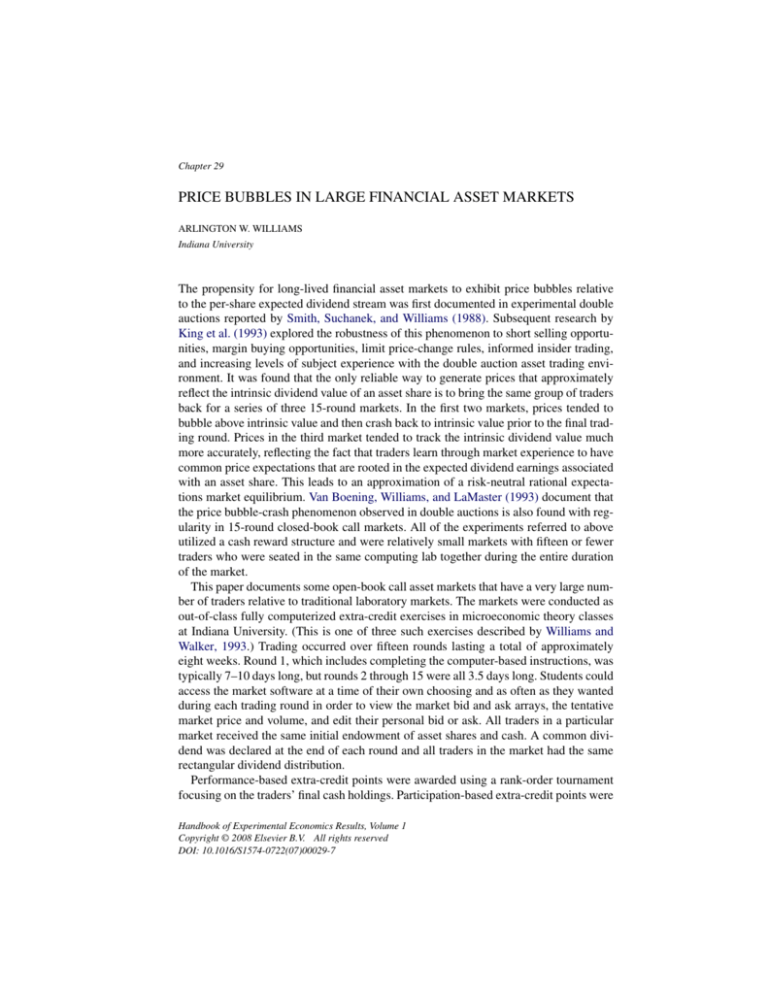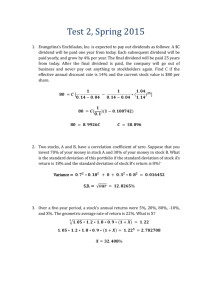
Chapter 29
PRICE BUBBLES IN LARGE FINANCIAL ASSET MARKETS
ARLINGTON W. WILLIAMS
Indiana University
The propensity for long-lived financial asset markets to exhibit price bubbles relative
to the per-share expected dividend stream was first documented in experimental double
auctions reported by Smith, Suchanek, and Williams (1988). Subsequent research by
King et al. (1993) explored the robustness of this phenomenon to short selling opportunities, margin buying opportunities, limit price-change rules, informed insider trading,
and increasing levels of subject experience with the double auction asset trading environment. It was found that the only reliable way to generate prices that approximately
reflect the intrinsic dividend value of an asset share is to bring the same group of traders
back for a series of three 15-round markets. In the first two markets, prices tended to
bubble above intrinsic value and then crash back to intrinsic value prior to the final trading round. Prices in the third market tended to track the intrinsic dividend value much
more accurately, reflecting the fact that traders learn through market experience to have
common price expectations that are rooted in the expected dividend earnings associated
with an asset share. This leads to an approximation of a risk-neutral rational expectations market equilibrium. Van Boening, Williams, and LaMaster (1993) document that
the price bubble-crash phenomenon observed in double auctions is also found with regularity in 15-round closed-book call markets. All of the experiments referred to above
utilized a cash reward structure and were relatively small markets with fifteen or fewer
traders who were seated in the same computing lab together during the entire duration
of the market.
This paper documents some open-book call asset markets that have a very large number of traders relative to traditional laboratory markets. The markets were conducted as
out-of-class fully computerized extra-credit exercises in microeconomic theory classes
at Indiana University. (This is one of three such exercises described by Williams and
Walker, 1993.) Trading occurred over fifteen rounds lasting a total of approximately
eight weeks. Round 1, which includes completing the computer-based instructions, was
typically 7–10 days long, but rounds 2 through 15 were all 3.5 days long. Students could
access the market software at a time of their own choosing and as often as they wanted
during each trading round in order to view the market bid and ask arrays, the tentative
market price and volume, and edit their personal bid or ask. All traders in a particular
market received the same initial endowment of asset shares and cash. A common dividend was declared at the end of each round and all traders in the market had the same
rectangular dividend distribution.
Performance-based extra-credit points were awarded using a rank-order tournament
focusing on the traders’ final cash holdings. Participation-based extra-credit points were
Handbook of Experimental Economics Results, Volume 1
Copyright © 2008 Elsevier B.V. All rights reserved
DOI: 10.1016/S1574-0722(07)00029-7
Ch. 29:
Price Bubbles in Large Financial Asset Markets
243
Figure 1. Asset market with 304 traders: a rising-price bubble and crash. Each trader is endowed with $150
and 12 asset shares at the beginning of round 1. At the end of each round, a per-share dividend is drawn from
a uniform distribution bounded at $1.50 and $0. The expected dividend is thus $.75. In round 1, the expected
dividend stream is 15 × $.75 = $11.25 per-share and falls by $.75 in each subsequent round.
also awarded in keeping with the educational goals of the exercise. Students participating in the market were encouraged to discuss the market with one another and to ask the
instructor any questions they might have about the trading procedures, dividend earnings, or the extra-credit reward structure. However, the instructor refused to reveal the
range of traders’ share or cash holdings since this information is unlikely to be available
in a naturally occurring market.
From a research perspective, these markets are important to the basic methodology
of experimental economics since very few experiments have addressed the potentially
critical issues of whether stylized results of typical small-group laboratory interactions
are robust to: (1) substantial increases in group size, (2) the endogenous inter-trader information flows that may exist outside of the strict privacy that is possible in laboratory
environments, (3) the enhanced cognition processes that may exist in decision rounds
lasting several days rather than a few minutes, and (4) non-monetary reward structures.
244
A.W. Williams
Figure 2. Asset market with 244 traders: a flat-price bubble and crash. Each trader is endowed with $225 and
25 asset shares at the beginning of round 1. At the end of each round, a per-share dividend is drawn from a
uniform distribution bounded at $1.50 and $.50. The expected dividend is thus $1. In round 1, the expected
dividend stream is 15 × $1 = $15 per-share and falls by $1 in each subsequent round.
(See Isaac, Walker, and Williams, 1994 for further discussion of these methodological
issues in the context of public goods experiments.)
Figures 1, 2, and 3 illustrate the market-clearing price (determined by the intersection of the submitted bids to buy and asks to sell), trading volume (as a percentage of
total shares outstanding), expected dividend stream, and maximum dividend stream for
markets with 304, 244, and 310 traders, respectively. The outcomes depicted in these
figures are characteristic of many such large call markets conducted over the past five
years. The basic price bubble-crash phenomenon is by far the most typical outcome.
This result is consistent with the cash-reward, small-group, strict-privacy lab experiments reported in the literature for inexperienced or once-experienced traders. One of
the more astonishing aspects of the large-group results is that the price bubble dynamic
appears to be unaffected by classroom discussions of the graph showing the market price
relative to the expected dividend stream (very similar to those shown in the figures) for
Ch. 29:
Price Bubbles in Large Financial Asset Markets
245
Figure 3. Asset market with 310 traders: a rare double bubble and crash. As in Figure 1, each trader is
endowed with $150 and 12 asset shares at the beginning of round 1. At the end of each round, a per-share
dividend is drawn from a uniform distribution bounded at $1.50 and $0. The expected dividend is thus $.75.
In round 1, the expected dividend stream is 15 × $.75 = $11.25 per-share and falls by $.75 in each subsequent
round.
a market that is still in progress. After viewing an on-line computer projection of the
market data and listening to a quick summary of the graph’s content, students frequently
ask questions like “Why are people buying at such high prices?” This instructor’s response is basically, “I really don’t know, but they must believe that they will be able
to profit from this action through dividend earnings and perhaps eventually selling the
share to someone else.” The traders who are doing the buying rarely choose to comment
publicly on their market strategy.
The lack of total control over inter-trader information flows and the ongoing interaction between subject (student) and experimenter (teacher) embodied in these educationally oriented large-group markets is atypical of pure-research endeavors. The results are
meaningful to the research methodology of experimental markets, however, since they
provide an explicit example of a very complex, and somewhat counter-intuitive, labora-
246
A.W. Williams
tory phenomenon. This phenomenon generalizes to a less controlled environment that
captures some critical elements of market interactions in the naturally-occurring world.
References
Isaac, R. Mark, Walker, James M., Williams, Arlington W. (1994). “Group size and the voluntary provision of
public goods: Experimental evidence utilizing very large groups”. Journal of Public Economics 54, 1–36.
King, Ronald R., Smith, Vernon L., Williams, Arlington W., Van Boening, Mark (1993). “The robustness of
bubbles and crashes in experimental stock markets”. In: Day, Richard H., Chen, Ping (Eds.), Nonlinear
Dynamics and Evolutionary Economics. Oxford University Press, Oxford, pp. 183–200.
Smith, Vernon L., Suchanek, Gerry L., Williams, Arlington W. (1988). “Bubbles, crashes and endogenous
expectations in experimental spot asset markets”. Econometrica 56, 1119–1151.
Van Boening, Mark, Williams, Arlington W., LaMaster, Shawn (1993). “Price bubbles and crashes in experimental call markets”. Economics Letters 41, 179–185.
Williams, Arlington W., Walker, James M. (1993). “Computerized laboratory exercises for microeconomics
education: Three applications motivated by experimental economics”. Journal of Economic Education 24,
291–315.






